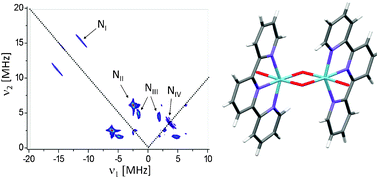Two-dimensional 14N HYSCOREspectroscopy of the coordination geometry of ligands in dimanganese di-μ-oxo mimics of the oxygen evolving complex of photosystem II†
Abstract
We use two-dimensional

* Corresponding authors
a
Department of Chemistry and Chemical Biology and The Baruch '60 Center for Biochemical Solar Energy Research, Rensselaer Polytechnic Institute, Troy, USA
E-mail:
lakshk@rpi.edu
Fax: +1 518 276 4887
Tel: +1 518 276 3271
We use two-dimensional

 Please wait while we load your content...
Something went wrong. Try again?
Please wait while we load your content...
Something went wrong. Try again?
R. Chatterjee, S. Milikisiyants and K. V. Lakshmi, Phys. Chem. Chem. Phys., 2012, 14, 7090 DOI: 10.1039/C2CP40416H
To request permission to reproduce material from this article, please go to the Copyright Clearance Center request page.
If you are an author contributing to an RSC publication, you do not need to request permission provided correct acknowledgement is given.
If you are the author of this article, you do not need to request permission to reproduce figures and diagrams provided correct acknowledgement is given. If you want to reproduce the whole article in a third-party publication (excluding your thesis/dissertation for which permission is not required) please go to the Copyright Clearance Center request page.
Read more about how to correctly acknowledge RSC content.
 Fetching data from CrossRef.
Fetching data from CrossRef.
This may take some time to load.
Loading related content
